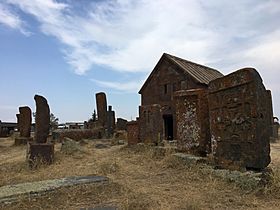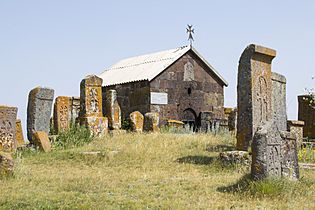Noratus facts for kids
Quick facts for kids
Noratus
Նորատուս
|
|
|---|---|

A view of Noratus
|
|
| Country | Armenia |
| Province | Gegharkunik |
| Municipality | Gavar |
| Elevation | 1,925 m (6,316 ft) |
| Population
(2011)
|
|
| • Total | 6,732 |
| Time zone | UTC+4 (AMT) |
| Noratus at GEOnet Names Server | |
Noratus (pronounced Nor-ah-toos, in Armenian: Նորատուս) is a village in Armenia. It's located in the Gegharkunik Province, close to the town of Gavar. Noratus is well-known for its amazing history. It is especially famous for the Noratus cemetery. This cemetery is the biggest in the world that still has many ancient stone crosses called khachkars.
A Look Back in Time

People first wrote about Noratus during the Middle Ages. Back then, it was a much bigger place. Near the village, there is an old fort from the Bronze Age. This fort suggests that Noratus is one of the oldest places in Armenia where people have lived without stopping.
There are many old monuments and records in and around the village. One famous church in Noratus is the St. Astvatsatsin Church. It stands in the middle of the village. Prince Sahak of Gegharkunik built this church in the late 800s.
The church was built with large, polished stones and had a dome. Over the centuries, parts of it were damaged. It is said that the dome and roof were destroyed a long time ago. Later, people from Alashkert helped to cover it with timbers. The church used to have a fenced yard. Today, this yard holds many khachkars and old gravestones. The oldest record found is on one of these khachkars. It is now kept in the State Museum of Armenian History.
Gavar Radio Station
Northeast of Noratus, you can find the Gavar transmitter. This is a large facility used for broadcasting radio signals. It sends out longwave, mediumwave, and shortwave radio programs.
Gallery
-
Khachkars in Noratus cemetery
See also
 In Spanish: Noratus para niños
In Spanish: Noratus para niños








